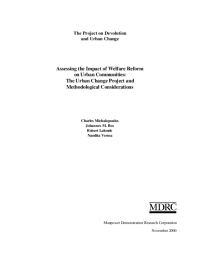Assessing the Impact of Welfare Reform on Urban Communities
The Urban Change Project and Methodological Considerations
Over the past few years, our nation’s social safety net has undergone a period of rapid and dramatic change, the third such period in sixty years. The last two upheavals, in the 1930s and the 1960s, left enduring legacies — Social Security, Medicare, and Medicaid are among the best-known examples — and generated far-reaching changes in American society. On August 22, 1996, President Clinton signed the historic Temporary Assistance for Needy Families (TANF) block grant legislation that heralds another period of major change. The reform embodies an interesting set of contrasts. On the one hand, it grants the states an extraordinary amount of flexibility to design whatever mix of services and benefits they think will reduce dependency and provide for the needy. On the other hand, the law is quite prescriptive about work participation requirements. Specifically, the 1996 law contains a five-year lifetime limit on receipt of federally funded cash assistance; authorizes states to impose shorter time limits at their discretion; requires that, by the year 2002, 50 percent of all recipients who have received cash aid for two years work at least 30 hours a week in order to continue receiving benefits (only about 14 percent of all recipients meet this definition currently); denies Food Stamp assistance and, at state discretion, cash benefits to all legal immigrants; allows states to withdraw 20 percent of the current state share of Aid to Families with Dependent Children (AFDC) costs; and permits 30 percent of all federal funds to be diverted to child care and other programs for non-AFDC recipients.
The Manpower Demonstration Research Corporation (MDRC) has undertaken an initiative that is examining how states, urban counties, and large cities restructure social welfare programs over the next several years. The overarching goal of its Project on Devolution and Urban Change is to assess whether “devolution” is generating the dramatic changes in policy and programs predicted by supporters and critics; just as important is to understand what difference these policies are making in the lives of low-income families. Begun in early 1997, the project will last approximately five years.
Welfare dependency and poverty have become increasingly concentrated in America’s largest cities. Furthermore, welfare agencies in large cities usually have had little success in moving recipients into jobs, so that the 1996 legislation poses significant implementation challenges in these settings. For these reasons, the Urban Change project is taking place in four large urban counties: Philadelphia, Los Angeles, Miami-Dade, and Cuyahoga (Ohio), which includes the city of Cleveland.
To provide depth and breadth to the analysis of welfare’s changes, the study includes five major components:
- An impact study to measure the economic effects of the new policies on individual welfare recipients and potential welfare recipients
- An implementation study to describe the new programs and policies as they are put in place
- An ethnographic study to look in depth at the experiences of a small number of families
- An institutional study to examine how the new policies and funding mechanisms affect both for-profit institutions and nonprofit and public service delivery systems
- A neighborhood indicators study to assess changes in the social and economic vitality of neighborhoods
The purpose of the Urban Change project is twofold: to describe income sources, income amounts, and well-being after devolution; and to infer the impacts of devolution on individuals, communities, and institutions by estimating what would have happened under AFDC. Although the five study components are designed to build on one another, and all five will be used in determining the effects of recent reform, this design paper focuses on the first component, the individual-level impact analysis. Information for the individual impact component will come from two sources. Administrative data on AFDC, TANF, Food Stamps, and earnings will be collected for all nonelderly parents of minor children who ever received Food Stamps or AFDC/TANF between 1992 and 2002 in the four counties. In addition, 2,000 single mothers receiving welfare in high-poverty neighborhoods will be surveyed in each county’s principal city. While the administrative data will allow us to precisely estimate changes in welfare and employment over time, the surveys will provide crucial information on other sources of income, child and parent well-being, family formation, experiences with the welfare system, and attitudes toward welfare and work.
This paper focuses on the portion of the impact analysis that uses administrative data. To infer impacts of the new policy on employment, earnings, and welfare, the study is using a multiple cohort design. In this design, a cohort, or group, of those receiving welfare or at risk of receiving welfare will be followed over time, and their outcomes will be compared. If patterns of behavior for cohorts who pass through reform differ markedly from patterns for those who are subject to the defunct rules of AFDC, this will be taken as evidence that welfare reform has had an impact. The remainder of this paper describes the multiple cohort design, investigates the power of the technique using data from a variety of sources, and discusses analytical issues which remain to be addressed.






